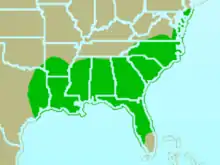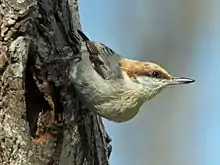Brown-headed nuthatch
The brown-headed nuthatch (Sitta pusilla) is a small songbird found in pine forests throughout the Southeastern United States. Genetic analyses indicated low differentiation between northern and southern populations in Florida, but the study also found lower genetic diversity among south Florida populations that may be a result of the increased habitat fragmentation that was documented. A population on the Bahamas showed moderate to high differentiation compared with Florida populations.[2] The Bahama nuthatch was and still is considered a subspecies (S. p. insularis) by several authorities including the IOC, but the IUCN and BirdLife International have reclassified it as its own separate species.[3] Two recent studies assessing vocalizations in Bahama and continental nuthatch populations found important differences.[4][5] One of the studies[4] also demonstrated that continental and Bahama populations did not respond aggressively to calls of the other population. This type of call-response study is often used to help define cryptic species.[6]
| Brown-headed nuthatch | |
|---|---|
 | |
| Scientific classification | |
| Kingdom: | Animalia |
| Phylum: | Chordata |
| Class: | Aves |
| Order: | Passeriformes |
| Family: | Sittidae |
| Genus: | Sitta |
| Species: | S. pusilla |
| Binomial name | |
| Sitta pusilla Latham, 1790 | |
| Subspecies | |
|
S. p. caniceps | |
 | |
| Range of S. pusilla | |

The bird, like other nuthatches, possesses a sharp black nail-like beak, which it uses to pound open seeds. It is a frequent visitor to feeding stations and is highly fond of sunflower seeds and suet cakes. Bold and inquisitive, this bird is readily approachable by humans.
The bird is regularly observed using a small chips of bark, small twigs, and pine needles held in its beak as tools to dig for insects.[7] The nuthatch exhibits other curious behaviors such a cooperative groups where groups of 3-5 adults provide care at a single nest.[8] Recent genetic assessments suggest some of the putatively non-breeding adults associated with these groups may actually breed with individuals in neighboring territories.[9] This nuthatch also exhibits a wide range of other social behaviors that include social grooming[10] and male-female duets similar to those observed for the Pygmy Nuthatch.[11]
Despite the other species' common name, the brown-headed nuthatch is about the same size as the pygmy nuthatch and the two species are the world's smallest nuthatches. In the brown-headed nuthatch, the total length is 9–11 cm (3.5–4.3 in), wingspan is 16–18 cm (6.3–7.1 in) and body mass is 10–12 g (0.35–0.42 oz).[12][13] This species sports a brown cap with narrow black eyeline and buff white cheeks, chin, and belly. Its wings are bluish-gray in color. A small white spot is found at the nape of the neck. The bird's call is a sharp whee-hyah sounding very similar to a "rubber duck" toy and particularly is loud for a bird its size. They also make softer "pit pit pit" calls while in flight as well as other squeaking noises. If heard or seen well, this species is virtually unmistakable in the wild, since it overlaps only with the very differently marked and larger red-breasted and white-breasted nuthatches.[14]
References
- BirdLife International (2012). "Sitta pusilla". IUCN Red List of Threatened Species. 2012. Retrieved 26 November 2013.CS1 maint: ref=harv (link)
- Han, Kin-Lan; Kimball, Rebecca T.; Cox, James A. (2019). "Testing hypotheses driving genetic structure in the cooperatively breeding Brown-headed Nuthatch Sitta pusilla". Ibis. 161 (2): 387–400. doi:10.1111/ibi.12642. ISSN 1474-919X.
- Hayes, William K.; Barry, Robert X.; McKenzie, Zeko; Barry, Patricia (2004). "Grand Bahama's Brown-headed Nuthatch: A Distinct and Endangered Species" (PDF). Bahamas Journal of Science. 12 (1): 21–28.
- Levy, Heather; Cox, James (2020-10-15). "Variation in responses to interspecific vocalizations among sister taxa of the Sittidae: imminent extinction of a cryptic species on Grand Bahama Island?". Avian Conservation and Ecology. 15 (2). doi:10.5751/ACE-01646-150215. ISSN 1712-6568.
- Boesman, Peter; Collar, N. J. (December 2020). "Further vocal evidence for treating the Bahama Nuthatch Sitta (pusilla) insularis as a species". Bulletin of the British Ornithologists' Club. 140 (4): 393–403. doi:10.25226/bboc.v140i4.2020.a4. ISSN 0007-1595.
- Freeman, Benjamin G.; Montgomery, Graham A. (2017-10-01). "Using song playback experiments to measure species recognition between geographically isolated populations: A comparison with acoustic trait analysesUsando experimentos de reproducción de cantos para medir el reconocimiento de especies entre poblaciones geográficamente aisladas: una comparación con análisis de rasgos acústicosPlayback experiments and acoustic divergence". The Auk. 134 (4): 857–870. doi:10.1642/AUK-17-63.1. ISSN 0004-8038.
- Gray, Mary Mack; Schunke, Elliot W.; Cox, James A. (June 2016). "Tool Usage by Juvenile Sitta pusilla (Brown-headed Nuthatch)". Southeastern Naturalist. 15 (2): N12–N15. doi:10.1656/058.015.0209. ISSN 1528-7092. S2CID 88701399.
- Cox, James A.; Slater, Gary L. (March 2007). "Cooperative Breeding in the Brown-Headed Nuthatch". The Wilson Journal of Ornithology. 119 (1): 1–8. doi:10.1676/06-006.1. ISSN 1559-4491. S2CID 86073307.
- Han, Kin-Lan; Cox, James A.; Kimball, Rebecca T. (December 2015). "Uncommon Levels of Relatedness and Parentage in a Cooperatively Breeding Bird, the Brown-Headed Nuthatch (Sitta pusilla)". The Wilson Journal of Ornithology. 127 (4): 593–600. doi:10.1676/14-193.1. ISSN 1559-4491. S2CID 86170699.
- Cox, James A. (December 2012). "Social Grooming in the Brown-Headed Nuthatch May have Expanded Functions". Southeastern Naturalist. 11 (4): 771–774. doi:10.1656/058.011.0415. ISSN 1528-7092. S2CID 85799935.
- Benedict, Lauryn (2008). "Occurrence and life history correlates of vocal duetting in North American passerines". Journal of Avian Biology. 39 (1): 57–65. doi:10.1111/j.0908-8857.2008.04103.x. ISSN 1600-048X.
- "Archived copy". Archived from the original on 2012-05-01. Retrieved 2012-04-02.CS1 maint: archived copy as title (link)
External links
| Wikimedia Commons has media related to Brown-headed Nuthatch. |
| Wikispecies has information related to Sitta pusilla. |
- Brown-Headed Nuthatch - Sitta pusilla - USGS Patuxent Bird Identification InfoCenter
- Brown-headed Nuthatch Species Account – Cornell Lab of Ornithology
- "Brown-headed Nuthatch media". Internet Bird Collection.
- Brown-headed Nuthatch Bird Sound at Florida Museum of Natural History
- Brown-headed Nuthatch photo gallery at VIREO (Drexel University)
